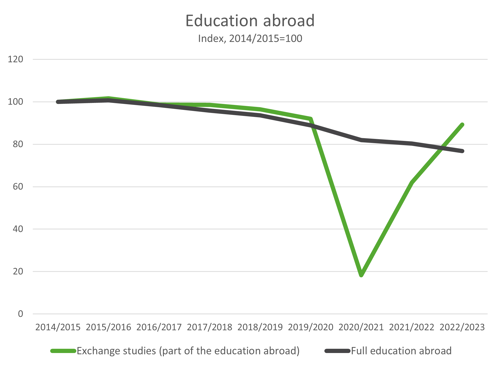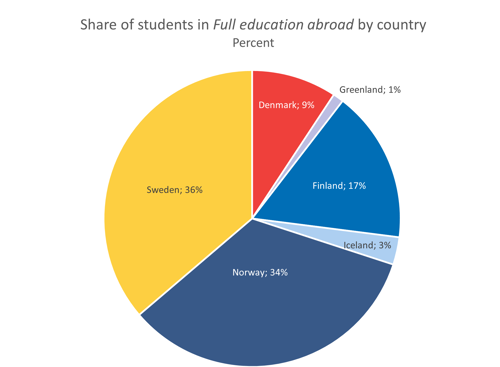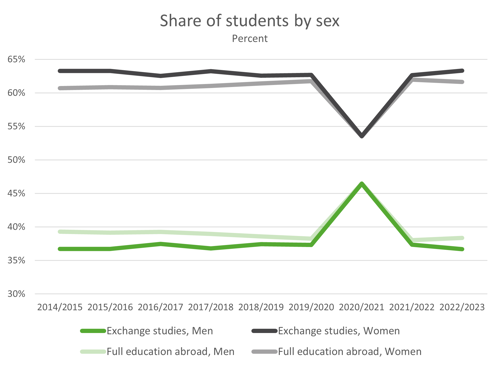Education abroad – back on track after the pandemic
In the academic year 2022/2023, just under 43,000 Nordic students were enrolled in a Full education abroad. This number has declined steadily over the past decade, although at a somewhat accelerated rate during the pandemic. For Exchange studies Covid-19 had a larger impact, but in 2022/2023 the number of students participating in this type of education abroad was almost back to pre-pandemic levels.
There are two types of studies abroad, a student can receive an entire education in another country (here referred to as Full education abroad) or participate in an exchange abroad as part of their studies in their home country (here referred to as Exchange studies). Abroad here refers to a country other then the home country, anywhere in the world.
Number of students over time
In the academic year 2014/2015, almost 56,000 Nordic students were enrolled in a Full education abroad [1]. The number has since decreased steadily, on average 3% per year, and landed just under 43,000 in 2022/2023. Compared with 2014/2015, this is a decrease by 23%. The dip in 2020/2021, the peak of the pandemic, was however larger than the other years, the number of students fell by 8% in this year alone. The decrease rate is now back to pre-pandemic levels.
The number of Nordic students participating in Exchange studies has been more volatile in the past nine years, and the effects of the pandemic were larger. Between 2014/2015 and 2019/2020, the development very much followed that of Full education abroad. But the first academic year of the pandemic, 2020/2021, the number of Nordic students participating in Exchange studies fell by 80% compared to the year before. The following year, 2021/2022, the number of exchange students increased again, by a staggering 239%. In 2022/2023, which is the most recent full year, the number increased again, by 44%, bringing it back to pre-pandemic levels. This resulted in the number of exchange students being only 3% below the pre-pandemic level of 2019/2020.

Source: Nordic Statistics Database, EDUC12
Please note that only three of the Nordic countries; Finland, Norway and Sweden, have been able to deliver data on Exchange studies. This means that the number of Nordic students participating cannot be reported, but the trends in development for the three countries that did deliver data can be assumed to be similar for the other countries as well.
Students by country
Of the 43,000 students enrolled in Full education abroad in 2022/2023, 70% came from Sweden (36%) or Norway (34%). 17% came from Finland, 9% from Denmark [2], 3% from Iceland and 1% from Greenland. This distribution has been stable over time, and no major pandemic effects can be seen.

Source: Nordic Statistics Database, EDUC12
Women participate more
Women participate in education abroad to a greater extent than men. The distribution between men and women has been very steady over time, with exception for the first pandemic year of 2020/2021. For 8 out of 9 years, the share of women has been 61-62% for Full education abroad and 63% for Exchange studies. In the academic year of 2020/2021, this changed slightly. The share of women went down, and the share of men went up accordingly for both types of education abroad, but for different reasons.
For Exchange studies it can be noted that the number of both men and women participating decreased significantly in 2020/2021, but for men slightly less than for women, resulting in a displacement of shares. In 2020/2021, the share of women was 54% and the share of men was 46%, a shift by 9 percentage points compared to the other years.
For Full education abroad, the number of men participating interestingly enough increased in 2020/2021, while the number of women decreased. This resulted in the distribution between the sexes attaining a full education abroad being identical to the distribution for exchange studies the same year, 54% for women and 46% for men a shift by 9 percentage points here as well. But then, in 2021/2022, the roles were reversed, the number of women went up while the number of men went back down and the difference between the sexes was back to the pre-pandemic distribution of 62% women and 38% men.

Source: Nordic Statistics Database, EDUC12
_______________________________________________________________________
[1] Data is limited to students who receive financial support. No data available for Faroe Islands or Åland, but Åland is included in the numbers for Finland.
[2] From 2018/2019 the data does not cover more long-term studies abroad for Denmark, but no significant decrease can be seen in the numbers.
_______________________________________________________________________